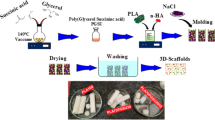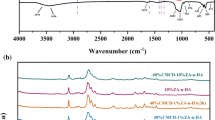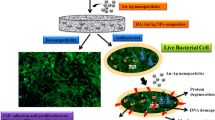Abstract
This work reports the synthesis and characterization of nanohydroxyapatite (nHA) and nanowhitlockite (nWH), which were further incorporated to poly-l-lactic acid (PLLA) to study their effects on the structure, mechanical properties, antibacterial potential, and cytotoxicity of PLLA. SEM images of PLLA–nHA and PLLA–nWH revealed uniform dispersion of nanoparticles in polymer. FTIR spectroscopy showed shift in functional group position and indicated transformation of PLLA α′ to more crystalline PLLA α, which was further confirmed by X-ray diffraction. The mechanical properties of the materials showed that addition of nanoparticles have made PLLA ductile and strong pertaining to the effective dissipation of loads across the interfaces, enabling them to delay the crack growth by avoiding stress concentration sites. PLLA–nWH10% showed the highest antibacterial activity against Gram-positive bacteria Listeria monocytogenes and Staphylococcus aureus. In vitro cytocompatibility of PLLA–nWH10% was highest, 98%, at day 7 against fibroblasts MC3T3-E1 (osteoblastic cell line), whereas all nanocomposites have enhanced cell viability (94%) as compared to pure PLLA. Alizarin red assay showed twofold increase in calcification at day 14 with PLLA–nWH as compared to PLLA–nHA. It was clearly observed that binary system PLLA–nWH at all concentrations had good dispersion and interfacial interaction resulting in improved mechanical and enhanced osteoconductive properties as compared to PLLA–nHA.











Similar content being viewed by others
Data availability
The raw/processed data required to reproduce these findings cannot be shared at this time, as the data also forms part of an ongoing study.
References
Ain QU, Khan ANJPC (2018) Fabrication and characterization of bio-inspired polymer blends and hybrid composites based on collagen-type II, polyethylene glycol-dimethacrylate and hydroxyapatite. Polym Compos 39:E550–E560
Ain QU et al (2017) Enhanced mechanical properties and biocompatibility of novel hydroxyapatite/TOPAS hybrid composite for bone tissue engineering applications. Mater Sci Eng C 75:807–815
Akindoyo JO et al (2019) Synergized poly(lactic acid)–hydroxyapatite composites: biocompatibility study. J Appl Polym Sci 136(15):47400
Alharbi HF et al (2018) Fabrication of core-shell structured nanofibers of poly (lactic acid) and poly (vinyl alcohol) by coaxial electrospinning for tissue engineering. Eur Polym J 98:483–491
Alizadeh Sardroud H et al (2017) Barium-cross-linked alginate-gelatine microcapsule as a potential platform for stem cell production and modular tissue formation. J Microencapsul 34(5):488–497
Amin S et al (2015) Synthesis and characterization of nano hydroxyapatite using reverse micro emulsions as nano reactors. J Chem Soc Pak 37(1):79–85
Athanasoulia I-GI et al (2017) The effect of hydroxyapatite nanoparticles on crystallization and thermomechanical properties of PLLA matrix. Pure Appl Chem 89(1):125–140
Beltrán F et al (2016) Water-induced structural changes in poly (lactic acid) and PLLA-clay nanocomposites. Polymer 107:211–222
Bhasney SM et al (2019) Morphology and crystalline characteristics of polylactic acid [PLA]/linear low density polyethylene [LLDPE]/microcrystalline cellulose [MCC] fiber composite. Compos Sci Technol 171:54–61
Capitelli F et al (2021) Neutron and XRD single-crystal diffraction study and vibrational properties of whitlockite, the natural counterpart of synthetic tricalcium phosphate. Curr Comput-Aided Drug Des 11(3):225
Chakrapani VY et al (2017) Electrospun cytocompatible polycaprolactone blend composite with enhanced wettability for bone tissue engineering. J Nanosci Nanotechnol 17(4):2320–2328
Chandran RR et al (2020) Evaluation of whitlockite through conventional hydrothermal method and its in-vitro erythrocyte compatibility and antibacterial activity. In: AIP conference proceedings, AIP Publishing LLC
Chatterjee K et al (2010) The effect of 3D hydrogel scaffold modulus on osteoblast differentiation and mineralization revealed by combinatorial screening. Biomaterials 31(19):5051–5062
Chen YC et al (2012) Functional human vascular network generated in photocrosslinkable gelatin methacrylate hydrogels. Adv Funct Mater 22(10):2027–2039
Cheng H et al (2018) Synergistic interplay between the two major bone minerals, hydroxyapatite and whitlockite nanoparticles, for osteogenic differentiation of mesenchymal stem cells. Acta Biomater 69:342–351
Christy PN et al (2020) Biopolymeric nanocomposite scaffolds for bone tissue engineering applications–a review. J Drug Deliv Sci Technol 55:101452
Cooper MA et al (2013) Wopmayite, ideally Ca6Na3 Mn (PO4)3 (PO3OH)4, a new phosphate mineral from the Tanco Mine, Bernic Lake, Manitoba: description and crystal structure. Can Mineral 51(1):93–106
Danoux CB et al (2014) In vitro and in vivo bioactivity assessment of a polylactic acid/hydroxyapatite composite for bone regeneration. Biomatter 4(1):e27664
Davachi SM et al (2016) In-vitro investigation and hydrolytic degradation of antibacterial nanocomposites based on PLLA/triclosan/nano-hydroxyapatite. Polymer 83:101–110
Davoodi S et al (2016) Preparation and characterization of interface-modified PLA/starch/PCL ternary blends using PLLA/triclosan antibacterial nanoparticles for medical applications. RSC Adv 6(46):39870–39882
Díaz E et al (2014) In vitro degradation of PLLA/nHA composite scaffolds. Polym Eng Sci 54(11):2571–2578
Díaz E et al (2019) PLLA/nHA composite films and scaffolds for medical implants: in vitro degradation, thermal and mechanical properties. J Inorg Organomet Polym Mater 29(1):121–131
Doosti-Telgerd M et al (2020) Nanofibrous scaffolds containing hydroxyapatite and microfluidic-prepared polyamidoamin/BMP-2 plasmid dendriplexes for bone tissue engineering applications. Int J Nanomedicine 15:2633
Dyke JC et al (2012) An investigation of siloxane cross-linked hydroxyapatite–gelatin/copolymer composites for potential orthopedic applications. J Mater Chem 22(43):22888–22898
Eftekhari S et al (2014) Fabrication and characterization of novel biomimetic PLLA/cellulose/hydroxyapatite nanocomposite for bone repair applications. Mater Sci Eng C 39:120–125
Farokhi M et al (2018) Silk fibroin/hydroxyapatite composites for bone tissue engineering. Biotechnol Adv 36(1):68–91
Gieroba B et al (2021) Collagen maturity and mineralization in mesenchymal stem cells cultured on the hydroxyapatite-based bone scaffold analyzed by ATR-FTIR spectroscopic imaging. Mater Sci Eng C 119:111634
Gunja NJ, Athanasiou KA (2010) Effects of hydrostatic pressure on leporine meniscus cell-seeded PLLA scaffolds. J Biomed Mater Res Part A 92(3):896–905
Harb SV et al (2020) Hydroxyapatite and β-TCP modified PMMA-TiO2 and PMMA-ZrO2 coatings for bioactive corrosion protection of Ti6Al4V implants. Mater Sci Eng C 116:111149
Hassan MI, Sultana N (2017) Characterization, drug loading and antibacterial activity of nanohydroxyapatite/polycaprolactone (nHA/PCL) electrospun membrane. 3 Biotech 7(4):1–9
Hickey DJ (2014) MgO nanocomposites as antibacterial biomaterials for orthopedic tissue engineering. Northeastern University, Boston
Hickey DJ et al (2014) MgO nanocomposites as new antibacterial materials for orthopedic tissue engineering applications. In: 2014 40th Annual northeast bioengineering conference (NEBEC), IEEE
Hickey DJ et al (2015) Adding MgO nanoparticles to hydroxyapatite–PLLA nanocomposites for improved bone tissue engineering applications. Acta Biomater 14:175–184
Hu X, Zhang W, Hou D (2020) Synthesis, microstructure and mechanical properties of tricalcium phosphate–hydroxyapatite (TCP/HA) composite ceramic. Ceram Int 46(7):9810–9816
Izadpanahi M et al (2018) Nanotopographical cues of electrospun PLLA efficiently modulate non-coding RNA network to osteogenic differentiation of mesenchymal stem cells during BMP signaling pathway. Mater Sci Eng C 93:686–703
Jang HL et al (2014) Revisiting whitlockite, the second most abundant biomineral in bone: nanocrystal synthesis in physiologically relevant conditions and biocompatibility evaluation. ACS Nano 8(1):634–641
Jang HL et al (2015) Phase transformation from hydroxyapatite to the secondary bone mineral, whitlockite. J Mater Chem B 3(7):1342–1349
Jang HL et al (2016) In vitro and in vivo evaluation of whitlockite biocompatibility: comparative study with hydroxyapatite and β-tricalcium phosphate. Adv Healthc Mater 5(1):128–136
Jin Y-Z et al (2019) Whitlockite promotes bone healing in rabbit ilium defect model. J Med Biol Eng 39(6):944–951
Kaliannagounder VK et al (2021) Remotely controlled self-powering electrical stimulators for osteogenic differentiation using bone inspired bioactive piezoelectric whitlockite nanoparticles. Nano Energy 85:105901
Kanani AG, Bahrami SH (2010) Review on electrospun nanofibers scaffold and biomedical applications. Trends Biomater Artif Organs 24(2):93–115
Kaya I et al (2019) Three dimensional printing and biomaterials in the repairment of bone defects; hydroxyapatite PLA filaments. Turk J Med Sci 49(3):922–927
Kim HD et al (2017) Biomimetic whitlockite inorganic nanoparticles-mediated in situ remodeling and rapid bone regeneration. Biomaterials 112:31–43
Kim I et al (2019) Osteogenic effects of VEGF-overexpressed human adipose-derived stem cells with whitlockite reinforced cryogel for bone regeneration. Macromol Biosci 19(5):1800460
Klinkaewnarong J, Utara S (2018) Ultrasonic-assisted conversion of limestone into needle-like hydroxyapatite nanoparticles. Ultrason Sonochemistry 46:18–25
Kraehenbuehl TP et al (2008) Three-dimensional extracellular matrix-directed cardioprogenitor differentiation: systematic modulation of a synthetic cell-responsive PEG-hydrogel. Biomaterials 29(18):2757–2766
Kumar S et al (2020) Enhanced mechanical properties and hydrophilic behavior of magnesium oxide added hydroxyapatite nanocomposite: a bone substitute material for load bearing applications. Ceram Int 46(10):16235–16248
Li S et al (2015) Structural changes and crystallization kinetics of polylactide under CO2 investigated using high-pressure Fourier transform infrared spectroscopy. Polym Int 64(12):1762–1769
Meaurio E, López-Rodríguez N, Sarasua J (2006a) Infrared spectrum of poly (L-lactide): application to crystallinity studies. Macromolecules 39(26):9291–9301
Meaurio E et al (2006b) Conformational behavior of poly (L-lactide) studied by infrared spectroscopy. J Phys Chem B 110(11):5790–5800
Mohseni M et al (2018) Assessment of tricalcium phosphate/collagen (TCP/collagene) nanocomposite scaffold compared with hydroxyapatite (HA) on healing of segmental femur bone defect in rabbits. Artif Cells Nanomedicine Biotechnol 46(2):242–249
Mondal S et al (2020) Hydroxyapatite nano bioceramics optimized 3D printed poly lactic acid scaffold for bone tissue engineering application. Ceram Int 46(3):3443–3455
Muthiah Pillai NS et al (2019) Injectable nano whitlockite incorporated chitosan hydrogel for effective hemostasis. ACS Appl Bio Mater 2(2):865–873
Nabavinia M, Khoshfetrat AB, Naderi-Meshkin H (2019) Nano-hydroxyapatite-alginate-gelatin microcapsule as a potential osteogenic building block for modular bone tissue engineering. Mater Sci Eng C 97:67–77
Nazeer MA, Yilgör E, Yilgör I (2017) Intercalated chitosan/hydroxyapatite nanocomposites: promising materials for bone tissue engineering applications. Carbohydr Polym 175:38–46
Nazir F, Iqbal M (2020) Synthesis, characterization and cytotoxicity studies of aminated microcrystalline cellulose derivatives against melanoma and breast cancer cell lines. Polymers 12(11):2634
Nazir F et al (2021a) Fabrication of robust poly L-lactic acid/cyclic olefinic copolymer (PLLA/COC) blends: study of physical properties, structure, and cytocompatibility for bone tissue engineering. J Mater Res Technol 13:1732–1751
Nazir F et al (2021b) 6-deoxy-aminocellulose derivatives embedded soft gelatin methacryloyl (GelMA) hydrogels for improved wound healing applications: in vitro and in vivo studies 185:419-433
Nie W et al (2017) Three-dimensional porous scaffold by self-assembly of reduced graphene oxide and nano-hydroxyapatite composites for bone tissue engineering. Carbon 116:325–337
Nosrati H et al (2020a) Nucleation and growth of brushite crystals on the graphene sheets applicable in bone cement. Boletín de la Sociedad Española de Cerámica y Vidrio 2020. https://doi.org/10.1016/j.bsecv.2020.05.001.
Nosrati H et al (2020b) Statistical evaluation of nano-structured hydroxyapatite mechanical characteristics by employing the Vickers indentation technique. Ceram Int 46(12):20081–20087
Nosrati H et al (2020c) Gas injection approach for synthesis of hydroxyapatite nanorods via hydrothermal method. Mater Charact 159:110071
Nosrati H et al (2020d) Evaluation of argon-gas-injected solvothermal synthesis of hydroxyapatite crystals followed by high-frequency induction heat sintering. Cryst Growth Des 20(5):3182–3189
Oner FK, Alakent B, Soyer-Uzun S (2021) Effect of silane A-174 modifications in the structure, chemistry, and compressive strength of PLA-HAP and PLA-β-TCP biocomposites: toward the design of polymer-ceramic implants with high performance. ACS Appl Polym Mater 3(5):2432–2446
Ou C-F, Hsu M-C (2007) Preparation and characterization of cyclo olefin copolymer (COC)/silica nanoparticle composites by solution blending. J Polym Res 14(5):373–378
Oustadi F et al (2020) Genipin-crosslinked gelatin hydrogel incorporated with PLLA–nanocylinders as a bone scaffold: Synthesis, characterization, and mechanical properties evaluation. Polym Adv Technol 31(8):1783–1792
Oyama HT et al (2020) Environmentally safe bioadditive allows degradation of refractory poly (lactic acid) in seawater: effect of poly (aspartic acid-co-l-lactide) on the hydrolytic degradation of PLLA at different salinity and pH conditions. Polym Degrad Stab 178:109216
Passos MF et al (2016) PHEMA-PLLA semi-interpenetrating polymer networks: a study of their swelling kinetics, mechanical properties and cellular behavior. Eur Polym J 85:150–163
Pavia FC et al (2018) Preparation, characterization and in vitro test of composites poly-lactic acid/hydroxyapatite scaffolds for bone tissue engineering. Int J Biol Macromol 119:945–953
Peng H et al (2016) Synthesis, swelling, degradation and cytocompatibility of crosslinked PLLA-PEG-PLLA networks with short PLLA blocks. Eur Polym J 84:448–464
Pitjamit S et al (2020) The possibility of interlocking nail fabrication from FFF 3D printing PLA/PCL/HA composites coated by local silk fibroin for canine bone fracture treatment. Materials 13(7):1564
Qi C et al (2015) Porous microspheres of magnesium whitlockite and amorphous calcium magnesium phosphate: microwave-assisted rapid synthesis using creatine phosphate, and application in drug delivery. J Mater Chem B 3(39):7775–7786
Raghavendran HRB et al (2014) A comparative study on in vitro osteogenic priming potential of electron spun scaffold PLLA/HA/Col, PLLA/HA, and PLLA/Col for tissue engineering application. PLoS One 9(8):e104389
Raghavendran HRB et al (2021) The functionalization of the electrospun PLLA fibrous scaffolds reduces the hydrogen peroxide induced cytokines secretion in vitro. Mater Today Commun 26:101812
Righetti MC et al (2017) Contribution of the rigid amorphous fraction to physical ageing of semi-crystalline PLLA. Polymer 125:241–253
Righetti MC, Delpouve N, Saiter A (2018) Physical ageing of semi-crystalline PLLA: role of the differently constrained amorphous fractions. In: AIP conference proceedings, AIP Publishing LLC
Rodenas-Rochina J et al (2015) Effects of hydroxyapatite filler on long-term hydrolytic degradation of PLLA/PCL porous scaffolds. Polym Degrad Stab 119:121–131
Sharma C et al (2016) Fabrication and characterization of novel nano-biocomposite scaffold of chitosan–gelatin–alginate–hydroxyapatite for bone tissue engineering. Mater Sci Eng C 64:416–427
Shuai C et al (2021) Accelerated degradation of HAP/PLLA bone scaffold by PGA blending facilitates bioactivity and osteoconductivity. Bioact Mater 6(2):490–502
Silver I, Murrills R, Etherington D (1988) Microelectrode studies on the acid microenvironment beneath adherent macrophages and osteoclasts. Exp Cell Res 175(2):266–276
Sroka-Bartnicka A et al (2017) Structural transformation of synthetic hydroxyapatite under simulated in vivo conditions studied with ATR-FTIR spectroscopic imaging. Spectrochim Acta Part A Mol Biomol Spectrosc 171:155–161
Szustakiewicz K et al (2018) Femtosecond laser-induced modification of PLLA/hydroxyapatite composite. Polym Degrad Stab 149:152–161
Teitelbaum SL (2000) Bone resorption by osteoclasts. Science 289(5484):1504–1508
Wang C et al (2020) Synthesis and formation mechanism of bone mineral, whitlockite nanocrystals in tri-solvent system. J Colloid Interface Sci 569:1–11
Wang T et al (2021) Three-dimensional printing of calcium carbonate/hydroxyapatite scaffolds at low temperature for bone tissue engineering. 3D Print Addit Manuf 8(1):1–13
Wijnhoven IB et al (2020) Analysis of cell-biomaterial interaction through cellular bridge formation in the interface between hGMSCs and CaP bioceramics. Sci Rep 10(1):1–14
Wu Z et al (2020) Biomimetic and osteogenic 3D silk fibroin composite scaffolds with nano MgO and mineralized hydroxyapatite for bone regeneration. J Tissue Eng 11:2041731420967791
Yang W-F et al (2018) Surface-modified hydroxyapatite nanoparticle-reinforced polylactides for three-dimensional printed bone tissue engineering scaffolds. J Biomed Nanotechnol 14(2):294–303
Yang Y et al (2020) Magnesium-based whitlockite bone mineral promotes neural and osteogenic activities. ACS Biomater Sci Eng 6(10):5785–5796
Zhang J et al (2005) Crystal modifications and thermal behavior of poly (L-lactic acid) revealed by infrared spectroscopy. Macromolecules 38(19):8012–8021
Zhang H et al (2017) Crystallization behavior of poly (lactic acid) with a self-assembly aryl amide nucleating agent probed by real-time infrared spectroscopy and X-ray diffraction. Polym Test 64:12–19
Zhang D et al (2021) Core-shell poly (l-lactic acid)-hyaluronic acid nanofibers for cell culture and pelvic ligament tissue engineering. J Biomed Nanotechnol 17(3):399–406
Zhao L-S, Cai Y-H (2018) Studies of poly (L-lactic acid)/hydroxyapatite composites through DSC and XRD. In: IOP conference series: materials science and engineering, IOP Publishing
Zhou D et al (2017) Comparative study of porous hydroxyapatite/chitosan and whitlockite/chitosan scaffolds for bone regeneration in calvarial defects. Int J Nanomedicine 12:2673
Zhu Y et al (2019) Poly (l-lactic acid)(PLLA) coatings with controllable hierarchical porous structures on magnesium substrate: an evaluation of corrosion behavior and cytocompatibility. ACS Appl Bio Mater 2(9):3843–3853
Acknowledgements
Prof. Ali Khademhosseini (CNSI, UCLA, CA, USA) facilitated biological characterization at his laboratory in UCLA, which the authors gratefully acknowledge.
Funding
This research received no external funding.
Author information
Authors and Affiliations
Contributions
FN: conceptualization, experimentation, software, writing—original draft preparation, writing—review and editing, MI: conceptualization, software, writing—original draft preparation, writing—review and editing, supervision, LA: writing—original draft preparation, writing—review and editing. All authors have read and agreed to the published version of the manuscript.
Corresponding author
Ethics declarations
Conflict of interest
The authors declare no conflict of interest.
Additional information
Publisher's Note
Springer Nature remains neutral with regard to jurisdictional claims in published maps and institutional affiliations.
Rights and permissions
About this article
Cite this article
Nazir, F., Abbas, L. & Iqbal, M. A comparative insight into the mechanical properties, antibacterial potential, and cytotoxicity profile of nano-hydroxyapatite and nano-whitlockite-incorporated poly-L-lactic acid for bone tissue engineering. Appl Nanosci 12, 47–68 (2022). https://doi.org/10.1007/s13204-021-02223-6
Received:
Accepted:
Published:
Issue Date:
DOI: https://doi.org/10.1007/s13204-021-02223-6




